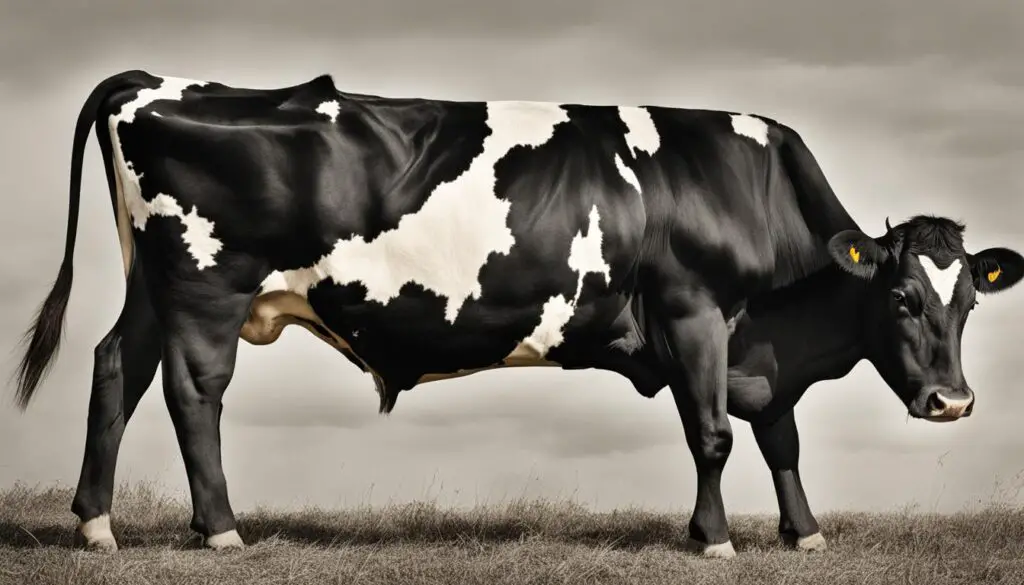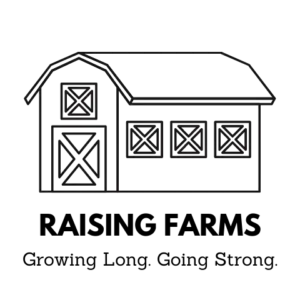Dairy cows have become an integral part of our daily lives, producing the milk and dairy products we consume regularly. But have you ever wondered where did dairy cows come from, or what is their history and origins?
Delve into the fascinating history of dairy cows with us and learn about their domestication, evolution, and how they have shaped the history of dairy farming. Gain a new appreciation for these remarkable animals and their role in our modern lives.
Key Takeaways:
- Dairy cows have a rich history dating back to ancient civilizations.
- The domestication of cattle was a major milestone that led to the emergence of dairy cows.
- Different breeds of dairy cows have been developed over time to suit milk production and farming practices.
- Dairy farming has a long history and has shaped the breeding, management, and care of dairy cows.
- Dairy cows remain essential to our lives today, producing the milk and dairy products we consume regularly.
The Domestication of Dairy Cows
Domestication is the process of adapting wild animals to live alongside humans and their lifestyle. The origins of dairy cows’ domestication began centuries ago. Initially, cows were domesticated for their meat, hides, bone, and milk for human consumption. As early as 8000 BC, evidence shows that cattle domestication occurred in Anatolia, a region that today forms part of modern-day Turkey.
Over time, domesticated cattle were bred for specific purposes, including milk production. Through selective breeding, modern-day dairy cows are the result of their genetic lineage, which allows them to produce milk in substantial quantities.
“Through selective breeding, modern-day dairy cows are the result of their genetic lineage, which allows them to produce milk in substantial quantities.”
The ancestry of dairy cows selected for milk production goes back centuries, and it was only through careful selective breeding that their milk-producing abilities were enhanced. Among the breeds that played a vital role in the development of modern-day dairy cows are the Ayrshire, Holstein, Guernsey, and Jersey breeds.
| Breeds | Milk Production per Day (liters) |
|---|---|
| Ayrshire | 20-30 |
| Holstein | 30-50 |
| Guernsey | 15-20 |
| Jersey | 10-20 |
As seen in the table above, different breeds of dairy cows produce varying levels of milk. Through selective breeding, dairy farmers can breed cows with high-quality milk and high yields. Today, domesticated dairy cows are reared worldwide, and they are highly valued for their milk and its by-products.
Evolution of Dairy Cows Through Time
Dairy cows have been a part of human civilization for thousands of years and have undergone significant evolutionary changes over time. The ancient origins of dairy cows can be traced back to the mountainous regions of Pakistan and India, where their ancestors roamed wild.
Early domestication of cattle began around 8,000 BC, and by 6,000 BC, dairy cattle were already being selectively bred for their desirable milk production. Through careful selection and breeding, early dairy farmers were able to develop cattle breeds that could produce larger quantities of milk, over longer periods, to fulfill the growing demands of human populations.
| Dairy Cows | Evolutionary Stage | Notable Characteristics |
|---|---|---|
| Bos primigenius taurus | Original Domesticated Cattle | Smaller, hardier, less productive |
| Bos taurus | Medieval Era | Larger, longer, and more productive milk production |
| Bos taurus modernus | Modern Day | Taller, better feed efficiency, and higher milk production |
Today, there are over 800 recognized dairy cattle breeds in the world, each with unique genetic attributes developed over centuries of selective breeding. These developments enabled the dairy industry to produce milk and its by-products on a larger scale, as well as to optimize the health and welfare of dairy cows.
“Through millennia of domestication, the evolution of dairy cows has been shaped by human needs, resulting in advanced genetic traits and breeding techniques that have propelled the industry forward.”
The Benefits of Selective Breeding
Through selective breeding, dairy farmers are able to improve the genetic traits of their cows to produce higher-quality milk and increase production. Specific genetic traits, such as feed efficiency, milk yield, and disease resistance can be selectively bred for and passed on to offspring through careful breeding programs. By identifying desirable traits and selecting suitable breeding partners, farmers can develop more efficient and productive cow herds.

A Glimpse into the History of Dairy Farming
Dairy farming has been an integral part of human society for thousands of years. The history of dairy farming can be traced back to ancient times, where archaeological evidence suggests that people in Africa and Europe kept domesticated cattle for their milk and meat. In fact, the ancient Egyptians were known for their extensive use of milk and dairy products, which were often used in religious rituals and ceremonies.
Over time, dairy farming techniques and practices evolved, influenced by factors such as climate, culture, and technology. In the United States, dairy farming began in the early 1600s, when English settlers brought cows with them to the New World. As the population grew, so did the demand for milk and dairy products, leading to the development of larger, more specialized dairy farms.
Today, dairy farming continues to play a vital role in our food system. Modern dairy farms employ advanced technology and scientific breeding practices to produce high-quality milk and dairy products. And while there have been concerns raised about the environmental impact of large-scale dairy farming, many farmers are working to implement sustainable practices to reduce their carbon footprint and protect the planet for future generations.
“Dairy farming is not just a job, it’s a way of life that requires dedication, hard work, and a commitment to the health and welfare of our animals.”
Overall, the history of dairy farming is a testament to the ingenuity and perseverance of human beings. From ancient civilizations to modern-day dairy farms, people have been working with cows and other animals to produce milk and dairy products that sustain and nourish us. As we continue to evolve and adapt to the changing world, it’s reassuring to know that dairy farming will always be a part of our cultural heritage and our shared future.
Conclusion
Through this journey into the origins and history of dairy cows, we have gained a deeper appreciation for these remarkable animals and their role in human society. The domestication process and genetic lineage have led to the development of specific breeds that are well-suited for milk production.
Over time, dairy farming practices have evolved alongside the breeding, management, and care of dairy cows, leading to increased efficiency and production. Today, dairy cows are an integral part of our lives, providing us with essential dairy products such as milk, cheese, and butter.
As we continue to rely on dairy cows for sustenance, it is essential to ensure their health and well-being. Advancements in technology and research have allowed us to improve the quality of dairy farming practices while maintaining the highest standards of animal welfare.
Overall, the history of dairy cows is a story of human ingenuity and the close relationship we have developed with these remarkable animals. Let us continue to honor and take care of them for generations to come.
FAQ
Where did dairy cows come from?
Dairy cows are believed to have originated from ancient wild oxen, specifically the wild aurochs (Bos primigenius), which were found in Europe, Asia, and North Africa. These wild oxen were domesticated thousands of years ago, leading to the development of the dairy cow as we know it today.
What is the history of dairy cows?
The history of dairy cows dates back thousands of years. The earliest evidence of domesticated dairy cows can be traced to around 4000 BCE in the Fertile Crescent, an area that includes modern-day Iraq and Iran. Over time, these cows were selectively bred for milk production, leading to the development of different breeds with specialized traits.
How were dairy cows domesticated?
Dairy cows were domesticated through a process of selective breeding, in which ancient humans selectively bred cattle for traits such as milk production, docility, and adaptability. This process involved capturing and taming wild aurochs, gradually transitioning them to a domesticated lifestyle that suited human needs.
What is the ancestry of dairy cows?
The ancestry of domestic dairy cows can be traced back to the wild aurochs, which roamed Eurasia and North Africa thousands of years ago. Through selective breeding and genetic adaptation, the ancestors of modern dairy cows gradually developed traits such as increased milk production and tolerance to dairy farming conditions.
How have dairy cows evolved over time?
Over time, dairy cows have evolved through selective breeding and genetic adaptation. Ancient humans bred cows with desired traits, such as higher milk production and ability to thrive in different environments. As a result, different breeds of dairy cows emerged, each with its own unique characteristics and milk-producing abilities.
What is the ancient origin of dairy cows?
The ancient origins of dairy cows can be traced back to the domestication of wild aurochs in the ancient Near East. As humans transitioned from a hunter-gatherer lifestyle to settled agriculture, they began selectively breeding cattle for milk production, leading to the emergence of dairy cows in different parts of the world.
What is the history of dairy farming?
The history of dairy farming dates back thousands of years. In ancient civilizations, such as those in Mesopotamia, Egypt, and India, dairy farming played a significant role in providing milk, butter, and cheese for their populations. Over time, advancements in breeding, technology, and management practices have shaped the development of modern dairy farming.

